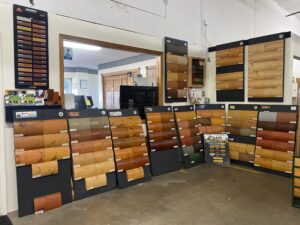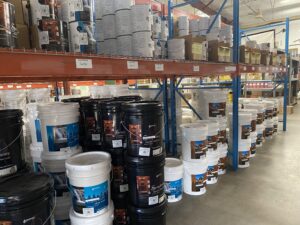 As co-owner and manager of Schroeder Log Home Supply, John Schroeder has been selling exterior care products for over 15 years. During his tenure, Schroeder has seen exterior wood care trends come and go. He shares with Paint & Decorating Retailer the trends to track for 2024 and best practices for selling exterior wood care products.
As co-owner and manager of Schroeder Log Home Supply, John Schroeder has been selling exterior care products for over 15 years. During his tenure, Schroeder has seen exterior wood care trends come and go. He shares with Paint & Decorating Retailer the trends to track for 2024 and best practices for selling exterior wood care products.
Dark Stains and Colors
Looking at the stain and paint colors of the year for 2024, dark colors are dominating the landscape for the year. Schroeder says he is seeing the same trend with customers wanting darker stain colors for their exterior projects.
When picking a color for staining, the process for application is fairly similar across pigments. Oftentimes, dark stains require more precision and can leave streaks if done incorrectly, whereas lighter colors are much more forgiving during the application process.
“An advantage to darker stains, or stains with higher amounts of pigmentation, is they typically offer more UV protection and consequently longer life,” Schroeder says. “But with more pigment added, you also displace the amount of binder ratio, and so the stain may break down and get chalky sooner.” Many of the modern exterior stain systems utilize a clear maintenance coat so that the performance benefits of pigment are protected by that top coat, Schroeder says. Because they dry faster, water-based stains are less forgiving compared to oil and lead to more drip marks and lap marks, but those challenges can be overcome by sound application methods, Schroeder says.
“In terms of color, black has been popular with our customers, often complimented with cedar tones or other colors,” Schroeder says. “It’s interesting pairing dark colors with natural tones. Most people like black, and it can be impactful to have it complemented with a cedar stain contrast to make them both pop.”
Schroeder is choosing one of these dark-toned colors of the year for his store’s renovations and updates. He’ll be using Onyx, the color of the year from Sansin on the outside trim of the building.
Limitations on VOCs
Through the Environmental Protection Agency (EPA) and the Clean Air Act of 1970, volatile organic compounds (VOCs) are regulated, and many states have enacted their own rules regarding VOCs, leading retailers to search for alternative options for customers. For Schroeder, regulations in different states limit what he’s able to sell.
“Limitations on VOCs and some deep penetrating oils make them difficult to source in most areas,” he says.
 Because of the regulations, as well as diversity in customer needs and preferences, Schroeder says he
Because of the regulations, as well as diversity in customer needs and preferences, Schroeder says he
carries a variety of formulas. Along with traditional penetrating oils, he carries waterborne finishes with plant-based resins considered to be cleaner alternatives. Latex and acrylic water-based finishes have also become more popular in recent years.
He also suggests providing education for your customers on VOCs and alternative products. Schroeder says he will give a basic explanation of what VOCs are if the customer is interested. In addition to his in-store education, Schroeder also offers his quarterly email newsletter, where he provides information about new products and other best practices related to exterior and interior wood care.
Customer Education
When ordering products for exterior wood care, Schroeder recommends becoming educated on basic wood science and coating chemistry to help customers make informed decisions. Schroeder says finding the perfect time window for exterior finishing in Minnesota is a challenge. For exterior projects, he recommends his customers pre-stain wood components indoors and watch the forecast for the ideal installation window.
“Surface temperature is more important than ambient temperature when staining,” Schroeder says. “In the heat of the summer, it’s advisable to plan work around the building to avoid direct sunlight, otherwise the surface may be too hot and the finish will flash dry and will fail to get a proper bond to the wood fiber.”
 Stocking moisture meters and surface temperature meters allows customers to ensure the surface is at optimum conditions for stain or finish adhesion and can contribute to add-on sales. When giving customers recommendations, Schroeder says asking good questions about the client’s project is important so you can give correct information.
Stocking moisture meters and surface temperature meters allows customers to ensure the surface is at optimum conditions for stain or finish adhesion and can contribute to add-on sales. When giving customers recommendations, Schroeder says asking good questions about the client’s project is important so you can give correct information.
“We’re educationally driven, so when it comes to helping customers make choices on finishes, we ask questions to learn more about their project, whether it’s new construction versus restoration, whether VOCs are a concern or not,” Schroeder says. “Depending on what their needs are, we steer them toward a few options. The decision is ultimately theirs, but we’re there to gather information, answer their questions and help their situation.”







